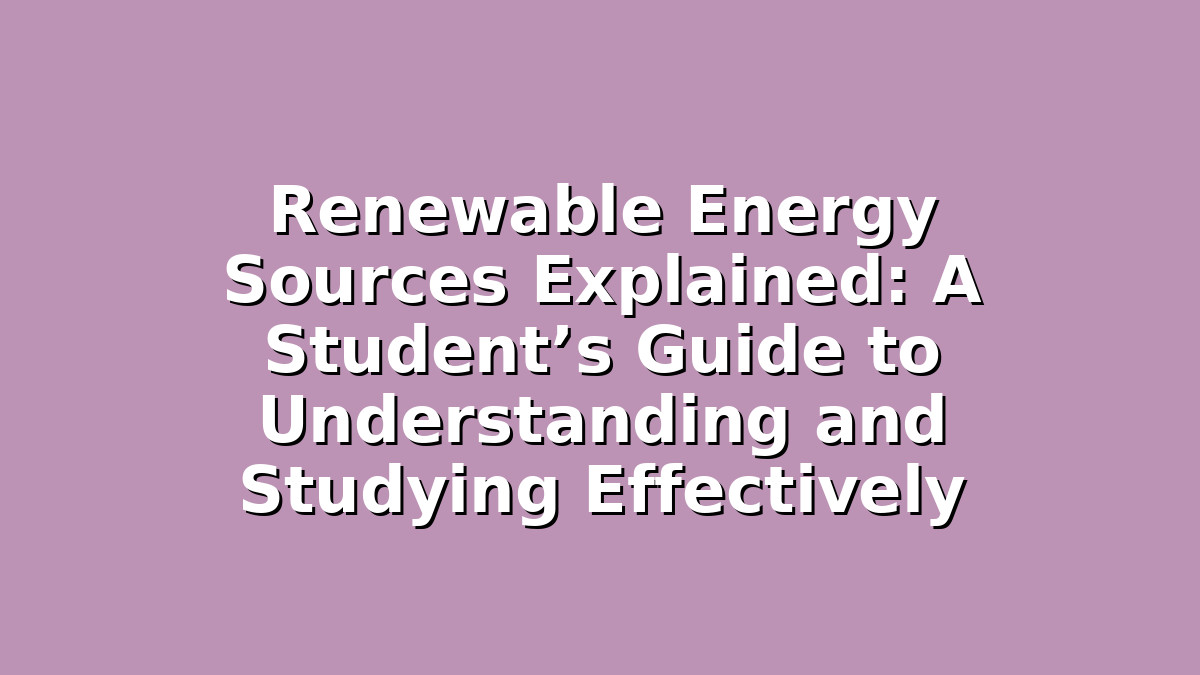As students preparing for exams, especially in subjects like science, geography, or environmental studies, understanding renewable energy sources is both important and fascinating. Not only is this topic relevant to today’s world, but mastering it can help you excel in your exams and develop a deeper appreciation for sustainable living. This guide will explain renewable energy sources in simple terms, provide detailed insights into key types, and offer study tips tailored to help you retain information and perform your best.
Introduction: Why Renewable Energy Matters for Students
Renewable energy refers to energy that comes from natural sources which are constantly replenished, such as sunlight, wind, and water. Unlike fossil fuels like coal and oil, which can run out and harm the environment, renewable energy is cleaner and sustainable. As global awareness about climate change grows, understanding these energy sources is crucial for young learners.
For students, renewable energy is a common exam topic, and grasping it well can boost your confidence and grades. This article will break down the main types of renewable energy, explore their benefits and challenges, and share study strategies that make learning easier and more effective.
—
Section 1: Solar Energy – Harnessing the Power of the Sun
Solar energy is one of the most widely used renewable energy sources. It involves converting sunlight into electricity or heat using solar panels or solar thermal systems.
How It Works:
Solar panels contain photovoltaic (PV) cells that absorb sunlight and convert it directly into electricity. Solar thermal systems use sunlight to heat water or air for homes and industries.
Why It’s Important:
– Solar energy is abundant and free once the panels are installed.
– It produces no pollution during operation.
– It reduces reliance on fossil fuels, helping lower greenhouse gas emissions.
Study Tip:
Create flashcards with key terms like “photovoltaic cells,” “solar thermal,” and “greenhouse gases.” Use these flashcards to quiz yourself or friends regularly. This active recall practice helps reinforce memory better than passive reading.
—
Section 2: Wind Energy – Power from the Air
Wind energy uses air movement to generate electricity through wind turbines. This form of energy has grown rapidly because wind farms can be set up on land or offshore.
How It Works:
Wind turbines have large blades that spin when wind passes over them. The spinning blades turn a generator that produces electricity.
Benefits:
– Wind energy is clean and renewable.
– It can be produced on a large scale to power entire communities.
– Modern turbines are becoming more efficient and quieter.
Challenges:
– Wind is intermittent—it doesn’t blow all the time, so energy storage solutions are critical.
– Some people worry about the impact on wildlife and noise.
Study Tip:
Use diagrams to visualize how wind turbines work. Drawing your own labeled sketches can improve understanding and retention. Additionally, explain the process out loud as if teaching someone else—this “Feynman technique” helps clarify concepts in your mind.
—
Section 3: Hydropower – Energy from Moving Water
Hydropower harnesses the energy of flowing or falling water to generate electricity. It’s one of the oldest and most reliable renewable energy sources.
How It Works:
Water flows through dams or river turbines, turning large turbines connected to generators. The kinetic energy from moving water is transformed into electrical energy.
Advantages:
– Hydropower plants can produce large amounts of energy continuously.
– They provide a steady and controllable power supply.
– It’s a clean energy source with zero emissions during operation.
Drawbacks:
– Building dams can affect ecosystems and displace communities.
– It depends on water availability, which can fluctuate during droughts.
Study Tip:
Make comparison tables that outline the pros and cons of different energy sources like hydropower, solar, and wind. This technique helps you quickly recall differences during exams. Also, consider forming study groups to debate real-world impacts of hydropower—engaging discussions deepen your knowledge and critical thinking skills.
—
Conclusion: Preparing for Success with Renewable Energy Knowledge
Studying renewable energy sources not only prepares you for exams but also equips you with knowledge to engage in important global conversations about sustainability. Remember, learning complex topics becomes easier when you use active study methods such as flashcards, drawing diagrams, teaching others, and group discussions.
Keep a positive mindset—every bit of effort brings you closer to mastering the material. Stay curious and try to connect what you learn with real-world examples. This approach makes studying less stressful and more meaningful.
Good luck with your exams! With dedication and smart study habits, you’ll do great.

Responses